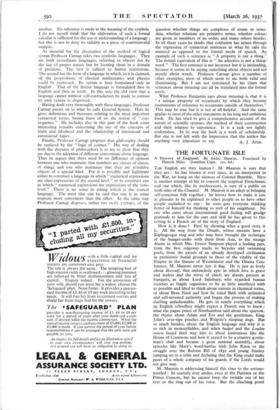SYNTAX AND SCIENCE
The Logical Syntax of Language. By Rudolf Carnap. (Kegan Paul. 25s.) The Logical Structure of Science. By A. Cornelius Benjamin. (Kegan Paul. tos. 6d.)
I HAVE always looked upon it as a weakness in the argument of Wittgenstein's Tractatus that it leads him to assert in the
end that his own propositions arc nonsensical. One reason for this is that he assigns questions concerning the structure of language to the realm of that which can be shown but not said. Professor Carnap, who owes much to Wittgenstein in other respects, dissents from him in this. " It is just as possible," he says, " to construct sentences about the forms of linguistic expressions as to construct sentences about the geometrical forms of geometrical structures. Thus syntax is exactly formulable in the same way as geometry is." The book in which he now offers us a justification of this thesis appeared originally in German about three years ago. It has been very ably translated by Countess von Zeppelin.
Even for one who is not intimidated by an extensive use of logistical symbolism, it is not an easy book to read. The style in which Professor Carnap writes is flat and passionless. I can think of no philosopher of equal eminence who is so indifferent to literary values. But, whatever its aesthetic defects, his book must command the admiration of all serious philosophers, alike for the fecundity of his ideas, the thorough- ness with which he pursues their implications and the technical skill with which he works them out.
" In the widest sense," says Professor Carnap, " logical syntax is the same thing as the construction and manipulation of a calculus." The logical syntax of a language will contain rules of two kinds ; rules of formation, which specify the combinations of symbols which constitute the various sorts of expressions that can occur in the language ; and ruler of transformation, which lay down the conditions under which expressions can legitimately be derived from one
another. No reference is made to the meaning of the symbols. I do not myself think that the elaboration of such a formal calculus is sufficient for the use or understanding of a language ; but this is not to deny its validity as a piece of combinatorial analysis.
As material for the illustration of the method of logical syntax Professor Carnap takes two symbolic languages. They are both co-ordinate languages, referring to objects not by the use of proper names but by locating them in a domain of positions. The first is subject to finitist restrictions. The second has the form of a language in which, so it is claimed, all the propositions of classical mathematics and physics could be expressed. Its syntax is here formulated only in English. That of the finitist language is formulated first in English and then in itself. In this way the old view that a language cannot without self-contradiction be made to contain its own syntax is disproved.
Having dealt very thoroughly with these languages, Professor Carnap passes on to what he calls General Syntax. Here he gives definitions and theorems relating to the most important syntactical terms, basing them all on the notion of " con- sequence." He includes also in this part of the book some interesting remarks concerning the use of the concepts of truth and falsehood and the relationship of intensional and extensional logics.
Finally, Professor Carnap proposes that philosophy, should be replaced by the " logic of science." His way of dealing with the disputes of philosophers is to try to show that they are due to the adoption of different conventions about language. Thus he argues that there need be no difference of opinion between one who maintains that numbers are classes of classes of things and one who maintains that they are primitive objects of a special kind. For it is possible and legitimate either to construct a language in which " numerical expressions are class-expressions of the second level " or to construct one in which " numerical expressions are expressions of the zero- level." There is no sense in asking which is the correct language. The most that can be said that one is in some respects more convenient than the other. In the same way Professor Carnap disposes, rather too easily perhaps, of the question whether things are complexes of atoms or sense- data, whether relations are primitive terms, whether colours are given as members of an order, and many others besides. In all these cases he thinks that confusion has arisen through the expression of syntactical sentences in what he rails the matetill as opposed to the formal mode of speech. An example of such a sentence is " A property is not a thing." The formal equivalent of this is " An adjective is not a thing- word." The first sentence is not incorrect but it is misleading, because it seems to be saying something about objects and not merely about words. Professor Carnap gives a number of other examples, most of which seem to me both valid and illuminating. But I am not convinced by his claim that sentences about meaning can all be translated into the formal mode.
What Professor Benjamin says about meaning is that it is " a unique property of occurrents by which they become instruments of reference to occurrents outside of themselves." This may be true but it is not at all helpful. And the same applies to most of the other statements in his long and ambitious book. He has tried to give a comprehensive account of the nature of scientific systems, the method of their construction and their relation to experience. It is a task not lightly undertaken. In its way the book is a work of scholarship. But one is not left with the impiession that the author has











































 Previous page
Previous page